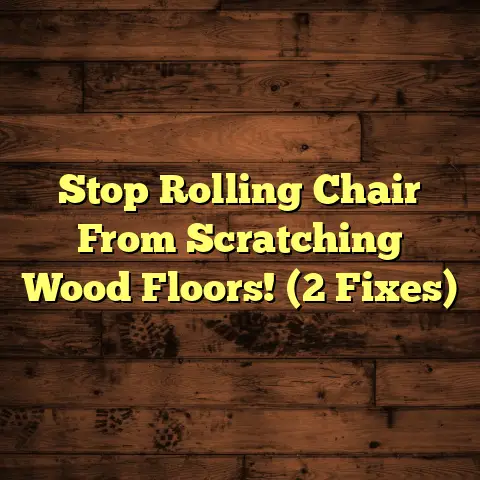How To Fill Small Gaps In Laminate Floors Effectively? (Explained)
Upgrading your lifestyle often starts with your living space.
I remember when I decided to renovate my home, focusing on the flooring.
A beautiful, seamless floor can transform a room, making it feel more inviting.
But what happens when small gaps appear in your laminate flooring?
These tiny spaces can disrupt the flow and beauty of your floors.
Today, I’ll share my experiences and insights on effectively filling those gaps, ensuring your laminate floors remain stunning and functional.
Identifying the Gaps
Gaps in laminate flooring can emerge for various reasons.
Temperature changes, humidity fluctuations, and the natural settling of a house can cause these spaces to form.
In my experience, I noticed gaps mostly around the edges of the planks, especially in high-traffic areas.
Have you ever felt the frustration of seeing those little spaces?
It’s like a small blemish on an otherwise perfect surface.
Measuring the Gaps
Before addressing the gaps, I recommend measuring them.
Using a caliper or a ruler can give you a precise idea of how wide and deep the gaps are.
Most gaps are usually less than 1/8 inch wide, but if they are larger, you might need to consider other solutions.
Choosing the Right Filler
When it comes to filling gaps in laminate floors, I’ve tried several approaches.
Here are the ones that worked best for me:
1. Caulk
Caulk is a popular choice for filling small gaps.
It’s flexible and can expand or contract with temperature changes.
Here’s how I use it:
- Select the Right Caulk: I prefer using paintable latex caulk for its ease of application and clean finish.
- Application: After cleaning the gap, I apply a thin line of caulk using a caulk gun.
A wet finger helps smooth out the surface for a neat look.
2. Wood Filler
For slightly larger gaps, wood filler can be effective.
I’ve used it when the gaps are around 1/8 inch wide.
Here’s my process:
- Choose Your Filler: Opt for a product designed for flooring to ensure compatibility.
- Application: After cleaning the area, I apply the filler with a putty knife, pushing it into the gap.
Once it dries, I sand it down to match the floor.
3. Foam Backer Rod
For wider gaps, foam backer rods can assist in creating a base for caulk or filler.
Here’s what I do:
- Insert the Rod: Place the foam backer rod into the gap, ensuring it’s slightly below the surface.
- Add Caulk: After inserting the rod, apply caulk over it for a smooth finish.
The Importance of Color Matching
One challenge I faced was color matching.
I learned quickly that using the right color is crucial for maintaining aesthetics.
If you’re using wood filler or caulk, always select a shade that closely resembles your laminate flooring.
I often took samples from leftover planks to aid in my selection.
Have you ever struggled with color matching?
It can be a tricky task!
Tools I Use
Having the right tools makes everything easier. Here’s what I usually keep handy:
- Caulking Gun: Essential for applying caulk smoothly.
- Putty Knife: Great for applying wood filler.
- Ruler or Caliper: For measuring gaps accurately.
- Sandpaper: Used to smooth out any excess filler after it dries.
- Vacuum Cleaner or Broom: To clean debris from gaps before filling.
- Painting Supplies: If you plan to paint over caulk or filler for a seamless look.
Estimated Costs
While working on my laminate flooring, cost was always a consideration.
Here’s a rough breakdown based on my experiences:
- Caulk: Approximately $5-$10 per tube.
- Wood Filler: Ranges from $7-$15 depending on brand and quantity.
- Foam Backer Rod: About $5 for a roll.
Using tools like FloorTally helped me keep track of these costs effectively.
It provided accurate estimates based on local rates, making budgeting much simpler.
Challenges Along the Way
Filling gaps isn’t always straightforward.
I faced a couple of challenges that taught me valuable lessons.
1. Overfilling
At first, I tended to overfill gaps, thinking it would create a seamless finish.
However, this often led to unsightly bulges after sanding.
Now, I apply just enough filler and check frequently during the drying process.
2. Uneven Flooring
Sometimes, gaps appeared due to uneven flooring underneath.
I learned to check for levelness before applying any filler or caulk.
If necessary, leveling compounds can help fix these underlying issues.
3. Timing Issues
I’ve also noticed that some fillers require specific drying times before sanding or painting over them.
It’s crucial to read labels carefully and plan your project timeline accordingly.
The last thing you want is to rush through and end up with a subpar finish.
Maintenance Tips
After successfully filling those pesky gaps, maintaining your laminate floor is essential.
Regular Cleaning: I sweep or vacuum regularly to prevent dirt buildup in the gaps.
Humidity Control: Using a dehumidifier can help maintain moisture levels in my home, reducing gap formation.
Periodic Checks: I make it a habit to inspect my floors every few months to catch any new gaps early.
Going Beyond Filling Gaps
While filling small gaps is crucial, sometimes it’s worth considering other enhancements for your flooring.
1. Expansion Gaps
Ensure there are proper expansion gaps around walls and fixtures when installing laminate flooring.
This allows for natural movement without creating new gaps.
2. Revisiting Installation Methods
3. Professional Help
Finally, don’t hesitate to call in professionals if you’re feeling overwhelmed or if the problem persists.
Sometimes an expert touch can save time and ensure quality work.
Understanding Laminate Floor Expansion
A common issue leading to gaps is insufficient expansion room during installation.
Laminate flooring needs space along the edges to accommodate expansion and contraction due to temperature and humidity changes.
Recommended Expansion Gap Sizes:
- Around walls: 1/4 inch
- Between planks: 1/8 inch
When installing laminate flooring, I always ensure these gaps are maintained to avoid future problems.
Installation Techniques
One installation method I found effective was using spacers during installation.
They help maintain consistent gaps around walls and fixed objects like cabinets or pipes.
Dealing with Larger Gaps
If you find yourself facing larger gaps—perhaps due to more significant settling or other issues—you may need to consider additional options or even replacement of certain planks.
Using Transition Strips
For larger gaps where two types of flooring meet (like laminate and tile), transition strips can offer a clean solution while accommodating movement.
Choosing Transition Strips:
- Match the color and style with your existing flooring.
- Ensure they’re suitable for your specific flooring types.
Specific Techniques I’ve Tried
Throughout my years as a flooring contractor, I’ve encountered various techniques for gap filling that have proven helpful in different scenarios.
1. Using Latex-Based Fillers
For performance and ease of cleanup, latex-based fillers have become my go-to option for small gaps.
They adhere well and are easy to sand once dry.
2. Staining After Filling
To achieve a more cohesive look after filling gaps with wood filler, I’ve experimented with staining over the filled areas once they dry completely.
This technique helps blend any inconsistencies in color.
3. Using Adhesive Caulk
For particularly stubborn gaps that seem resistant to traditional fillers, adhesive caulk has proven effective in providing a long-lasting seal while allowing some movement.
Practical Applications for Maintenance
Keeping your laminate flooring looking fresh doesn’t end after filling those gaps.
Here are some practical tips I’ve found useful:
Regular Cleaning Regimen
I usually set aside time every week for a thorough clean:
- Use a soft broom or vacuum without a beater bar.
- Follow up with a damp mop using laminate-friendly cleaning solutions.
This routine helps maintain not just appearance but also protects against debris buildup in those filled areas.
Seasonal Inspections
Every season, I take time to inspect my floors closely:
- Look for any new gaps that may have formed.
- Check the condition of filled areas—are they holding up well?
Being proactive helps prevent small issues from turning into costly repairs later on.
Troubleshooting Common Problems
Even with good maintenance practices, problems can still arise.
Here are some common issues I’ve encountered along with solutions:
Problem: Gaps Reappearing
If you notice that filled gaps are reappearing after some time:
- Check humidity levels in your home; excessive moisture can expand flooring materials.
- Inspect surrounding areas for any signs of water damage that may lead to further issues.
Problem: Filler Cracking
If your filler starts cracking after some time:
- Ensure you’re using high-quality products designed specifically for flooring.
- Avoid heavy foot traffic until fillers have fully cured based on manufacturer instructions.
Professional Restoration Options
If DIY solutions aren’t cutting it or if you’re dealing with extensive damage:
Hiring Experts
Consider bringing in professional help for:
- Assessing underlying issues causing gap formation.
- Replacing damaged planks if necessary.
Professionals have access to specialized tools and techniques that can restore your floors effectively.
Comparing Solutions: DIY vs Professional Help
When weighing options between DIY solutions and hiring professionals:
DIY Approach
Advantages:
- Cost savings
- Personal satisfaction from completing projects yourself
Disadvantages:
- Time-consuming
- Requires knowledge of proper techniques
Professional Approach
Advantages:
- Expertise in handling complex issues
- Access to specialized tools and materials
Disadvantages:
- Higher costs
- Scheduling conflicts or delays
Ultimately, it’s about finding what works best for your situation—balance between personal capability and budget considerations.
Final Thoughts
Filling small gaps in laminate flooring may seem like a minor task, but it holds significant importance in maintaining both aesthetics and functionality.
With my experiences and tips outlined here, I hope you feel empowered to tackle this project yourself.
Have you faced similar challenges with your laminate flooring?
What solutions have worked best for you?
Let’s keep this conversation going!
Whether it’s tackling small repairs or considering larger renovations, every step contributes to enhancing your home environment and lifestyle.





